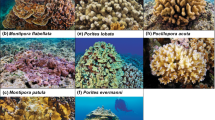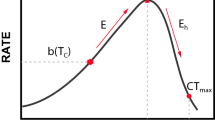Abstract
The physiological responses of organisms to resources and environmental conditions are important determinants of niche boundaries. In previous work, functional relationships between organism energetics and environment have been limited to energy intakes. However, energetic costs of maintenance may also depend on the supply of resources. In many mixotrophic organisms, two such resource types are light and particle concentration (turbidity). Using two coral species with contrasting abundances along light and turbidity gradients (Acropora valida and Turbinaria mesenterina), we incorporate the dual resource-stressor roles of these variables by calibrating functional responses of energy costs (respiration and loss of organic carbon) as well as energy intake (photosynthesis and particle feeding). This allows us to characterize physiological niche boundaries along light and turbidity gradients, identify species-specific differences in these boundaries, and assess the sensitivity of these differences to interspecific differences in particular functional response parameters. The turbidity-light niche of T. mesenterina was substantially larger than that of A. valida, consistent with its broader ecological distribution. As expected, the responses of photosynthesis, heterotrophic capacity, respiration, and organic carbon loss to light and turbidity varied between species. Niche boundaries were highly sensitive to the functional responses of energy costs to light and turbidity. Moreover, the study species’ niche differences were almost entirely attributable to species-specific differences in one functional response: that of respiration to turbidity. These results demonstrate that functional responses of energy-loss processes are important determinants of species-specific physiological limits to growth, and thereby of niche differences in reef corals. Given that many resources can stress organisms when supply rates are high, we propose that the functional responses of energy losses will prove to be important determinants of niche differences in other systems as well.


Similar content being viewed by others
References
Acevedo R, Morelock J, Olivieri RA (1989) Modification of coral reef zonation by terrigenous sediment stress. Palaios 4:92–100
Anthony KRN (1999) Coral suspension feeding on fine particulate matter. J Exp Mar Biol Ecol 232:85–106
Anthony KRN, Fabricius KE (2000) Shifting roles of heterotrophy and autotrophy in coral energetics under varying turbidity. J Exp Mar Biol Ecol 252:221–253
Anthony KRN, Hoegh-Guldberg O (2003a) Kinetics of photoacclimation in corals. Oecologia 134:23–31
Anthony KRN, Hoegh-Guldberg O (2003b) Variation in coral photosynthesis, respiration and growth characteristics in contrasting light microhabitats: an analogue to plants in forest gaps and understoreys? Funct Ecol 17:246–259
Anthony KRN, Ridd PV, Orpin AR, Larcombe P, Lough JM (2004) Temporal variation in light availability in coastal benthic habitats: effects of clouds, turbidity and tides. Limnol Oceanogr (in press)
Barnes DJ, Chalker BE (1990) Calcification and photosynthesis in reef-building corals and algae. In: Dubinsky Z (ed) Ecosystems of the world: coral reefs, vol 25. Elsevier, Amsterdam, pp 109–131
Brose U, Williams RJ, Martinez ND (2003) Comment on foraging adaptation and the relationship between food web complexity and stability. Science 301:918b
Calow P, Forbes VE (1998) How do physiological responses to stress translate into ecological and evolutionary processes. Comp Biochem Phys A 120:11–16
Calow P, Sibly RM (1990) A physiological basis of population processes: ecotoxicological implications. Funct Ecol 4:283–288
Chalker BE, Dunlap WE, Oliver JK (1983) Bathymetric adaptations of reef-building corals at Davies Reef, Great Barrier Reef, Australia. II. Light saturation curves for photosynthesis and respiration. J Exp Mar Biol Ecol 73:37–56
Chazdon RL, Pearcy RW, Lee DW, Fetcher N (1996) Photosynthetic responses of tropical forest plants to contrasting light environments. In: Mulkey SS, Chazdon RL, Smith AP (eds) Tropical forest plant ecophysiology. Chapman and Hall, London, pp 5–55
Chesson P, Huntly N (1997) The roles of harsh and fluctuating conditions in the dynamics of ecological communities. Am Nat 150:519–553
Crossland CJ (1987) In situ release of mucus and DOC-lipid from the coral Acropora variabilis and Stylophora pistillata. Coral Reefs 6:35–42
Done TJ (1982) Patterns in the distribution of coral communities across the central Great Barrier Reef. Coral Reefs 1:95–107
Done TJ (1983) Coral zonation: its nature and significance. In: Barnes DJ (ed) Perspectives on coral reefs. Australian Institute of Marine Science, Canberra, pp 107–147
Emery NC, Ewanchuk PJ, Bertness MD (2001) Competition and salt-marsh plant zonation: stress tolerators may be dominant competitors. Ecology 82:2471–2485
Falkowski PG, Raven JA (1997) Aquatic photosynthesis. Blackwell, Oxford
Ferrier-Pages C, Allemand D, Gattuso JP, Jaubert J, Rassoulzadegan R (1998) Microheterotrophy in the zooxanthellate coral Stylophora pistillata: effects of light and ciliate density. Limnol Oceanogr 43:1639–1648
Gurney WSC, Middleton DAJ, Nisbet RM, McCauley E, Murdoch WM, DeRoos A (1996) Individual energetics and the equilibrium demography of structured populations. Theor Popul Biol 49:344–368
Hutchinson GE (1957) Concluding remarks. Cold Spring Harb Symp Quant Biol 22:415–427
Kooijman SALM (2000) Dynamic energy and mass budgets in biological systems, 2nd edn. Cambridge University Press, Cambridge
Lambers H, Chapin FS III, Pons TL (1997) Plant physiological ecology. Springer, Berlin Heidelberg New York
Larcombe P, Costen A, Woolfe KJ (2001) The hydrodynamic and sedimentary setting of nearshore coral reefs, central Great Barrier Reef shelf, Australia: Paluma Shoals, a case study. Sedimentology 48:811–835
Larcombe P, Ridd PV, Prytz A, Wilson B (1995) Factors controlling suspended sediment on inner-shelf coral reefs, Townsville, Australia. Coral Reefs 14:163–171
Leibold MA (1995) The niche concept revisited: mechanistic models and community context. Ecology 76:1371–1382
Maltby L (1999) Studying stress: the importance of organism-level responses. Ecol Appl 9:431–440
McClanahan TR, Obura D (1997) Sedimentation effects on shallow coral communities in Kenya. J Exp Mar Biol Ecol 209:103–122
Muscatine L (1990) The role of symbiotic algae in carbon and energy flux in reef corals. In: Dubinsky Z (ed) Ecosystems of the world: coral reefs, vol 25. Elsevier, Amsterdam, pp 75–87
Nisbet RM, Muller EB, Lika K, Kooijman SALM (2000) From molecules to ecosystems through energy budget models. J Anim Ecol 69:913–926
Ohmann JL, Spies TA (1998) Regional gradient analysis and spatial pattern of woody plant communities of Oregon forests. Ecol Monogr 68:151–182
Patterson MR, Sebens KP (1989) Forced convection modulates gas exchange in cnidarians. Proc Natl Acad Sci USA 86:8833–8836
Porter JW (1976) Autotrophy, heterotrophy, and resource partitioning in Caribbean reef-building corals. Am Nat 110:731–742
Riegl B, Branch GM (1995) Effects of sediment on the energy budgets of four scleractinian (Bourne 1900) and five alcyonacean (Lamouroux 1816) corals. J Exp Mar Biol Ecol 186:259–275
Rogers CS (1990) Responses of coral reefs and reef organisms to sedimentation. Mar Ecol Prog Ser 62:185–202
Seabloom EW, Moloney KA, van der Valk AG (2001) Constraints on the establishment of plants along a fluctuating water-depth gradient. Ecology 82:2216–2232
Sebens KP (1982) Limits to indeterminate growth: an optimal size model applied to passive suspension feeders. Ecology 63:209–222
Sebens KP (1987) The ecology of indeterminate growth in animals. Annu Rev Ecol Syst 18:371–407
Shick JM (1991) A functional biology of sea anemones. Chapman and Hall, London
STATISTICA (2001) STATISTICA (data analysis software system), version 6. StatSoft, Tulsa
Sultan SE, Bazzaz FA (1993) Phenotypic plasticity in Polygonum persicaria. III. The evolution of ecological breadth for nutrient environment. Evolution 47:1050–1071
Veron JEN (1986) Corals of Australia and the Indo-Pacific, 2nd edn. University of Hawaii Press, Honolulu
Withers PC (1992) Comparative animal physiology. Saunders College, Fort Worth
Acknowledgements
This study was funded by the Australian Research Council (grant No. A00105071 to K.R.N.A. and grant No. DP0209047 to S.R.C. and LP0453612 to the CCRB) and a JCU Merit Research Grant. We thank Tove Lemberget, Liz Madin, Pia Rheinlander, and Tim Prior for their assistance in the laboratory, Michael Bode for help with the MATLAB code for Monte Carlo analyses, and to the Australian Institute of Marine Science for use of the CHN analyzer. This is contribution number 81 from the Centre for Coral Reef Biodiversity.
Author information
Authors and Affiliations
Corresponding author
Appendices
Appendix 1
Rate of photosynthesis versus average daily irradiance
To test the efficacy of using average irradiance during the day rather than irradiance-time profiles in our calculations of daily rates of photosynthesis, we compared the outputs of these two methods for 12 days with varying maximum (1200 hours) irradiances (Inoon, 10–1,500 μmol m−2 s−1). Method 1 used a traditional irradiance sine function with a 12-h day length as input [It=Inoon sin(tπ/12), where It is irradiance averaged over a 1-h window and t is hours since sunrise], whereas method 2 used the average daily irradiance (I) as input. Daily gross rate of photosynthesis for method 1 was calculated as
and for method 2 as
where Pmax is maximum hourly rate of photosynthesis and Ik is the irradiance at which the rate of photosynthesis is ~75% of maximum. Pmax and Ik are functions of I according to Eq. 8 (Anthony and Hoegh-Guldberg 2003a). Plotting Pg2 against Pg1 indicates negligible bias (Pg2≅ Pg1) for 1200 hours irradiances below 300 μmol m−2 s−1 (Fig. 3) . Thus, for the low light regimes characteristic of high-turbidity environments, the two methods produce nearly identical estimates of daily rates of photosynthesis.
Appendix 2
Confidence limits of niche boundaries using Monte Carlo analysis
To model energy balance for a given turbidity and irradiance, we used parameter estimates, their statistical variances, and (where applicable) their statistical covariances. We followed standard Monte Carlo procedure, sampling sets of parameter values from the multivariate normal distribution specified by the parameter estimates and their associated variance covariance matrices (Table 5). This procedure was repeated for a range of turbidity (1–200 mg l−1) and irradiance (0–300 μmol m−2 s−1) values. The sampling procedure was repeated 1,000 times for each turbidity-irradiance combination, and the standard deviation at each combination used as the confidence limits for the location of zero-EB isoclines.
Rights and permissions
About this article
Cite this article
Anthony, K.R.N., Connolly, S.R. Environmental limits to growth: physiological niche boundaries of corals along turbidity–light gradients. Oecologia 141, 373–384 (2004). https://doi.org/10.1007/s00442-004-1647-7
Received:
Accepted:
Published:
Issue Date:
DOI: https://doi.org/10.1007/s00442-004-1647-7





